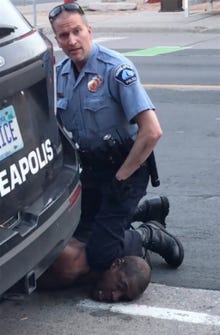There is no end to the trouble caused when police push detained suspects over the River Styx a moment before their allotted time. When they use chokeholds, batons or knees to the neck and back, rough rides in the jail van, or a poke to the breadbasket with the Kel-lite, they can kill suspects who are already dying for reasons that have nothing to do with police.
The toll paid by the city is far higher than the gold coin paid to the mythic ferryman: riots, arson, looting and rape; lawsuits and huge settlements; insufferable politicians and smarmy attorneys blustering before media mobs and click-happy Instagramers. Chiefs will be forcibly retired or fired, cops charged with homicide, businesses ruined, and citizens murdered as hoodlums take advantage of chaos and hesitant policing to settle scores and win turf.
Police will always be blamed for killing these walking dead. The obloquy will never cease as long as cops are ignorant of, and untrained for, handling tough guys who can put a cop on the ground with one punch, then drop dead themselves immediately afterward.
While these redball homicides are ascribed routinely to asphyxiation and strangulation (“I can’t breathe!”), it is just as likely that they are due to heart attacks, angina, fibrillation and tachycardia, all of which induce a feeling of being unable to breathe because, although the lungs are filling, diseased hearts cannot pump enough blood to take up oxygen.
Trail Mix
The most dramatic cause of heart attacks and respiratory failure in young adults is amphetamine and opiate abuse. Perps routinely ingest multiple, scheduled narcotics, which cops jocularly refer to as “trail mix.” Cocaine and methamphetamine cause severe hardening of the arteries which can induce heart attacks, arrythmia and strokes. These drugs can explode, or in the laconic vocabulary of emergency medicine, “dissect”, arteries small and large. I saw this up close a year ago in a trauma unit when two lean and muscular meth addicts in their 30s died of heart attacks within minutes of each other.
Opiates are always in the mix. Heroin, fentanyl, oxycodone and hydrocodone paralyze the diaphragm. Abusers will routinely swallow several 80-mg oxys (oxycodone), enough to stop a bull elephant. As for fentanyl, in the hospital, it’s pharmaceutical grade; in the wild, it’s cooked up by peasants using precursors shipped in bulk to Vera Cruz, Mexico. Dosages are, shall we say, variable and often contaminated with methylates and carboxyls, plus the occasional rat.
This is just some of the stuff roaring through the blood and brains of frenzied suspects flailing and screaming on the side of the road with the blue lights flashing.
Fruits and Nuts
On top of trail mix, perps add legal drugs whose reactions with scheduled narcotics are unknown and unknowable since scientists cannot ethically study fatal drug mixtures. These are nicotine, caffeine, alcohol and tetrahydrocannabinol, aka marijuana, hashish, kief, etc. Nicotine and caffeine make the heart race and the blood pressure rise. Alcohol depresses breathing, multiplies the effect of opiates, and masks the effects of amphetamines. As for marijuana, it induces a false sense of well-being as in, “Wow, I can’t breathe. That’s sooo cool!”
The Goodie
Trail mix users want the goodie first, usually fentanyl or heroin. When they start to pass out, they may toke methamphetamine and—Fuckin’ A!—reawaken to notice that their arteries are throbbing and their heads exploding. Naturally they will smooth that out with a joint and some booze.
“Oh, yeah!”
The Cherry on Top
Like a chocolate sundae, trail mix is incomplete without cherries on top—hallucinogens. Among criminal defendants I’ve interviewed, these are never mescaline and psilocybin, which are expensive hippie/preppy drugs, but phencyclidine (PCP, aka angel dust), 3,4-methylenedioxy-methamphetamine (MDMA, aka ecstasy) and chemical analogs of same (mollie).
Add to this the most powerful hallucinogens of all, the brain chemicals that induce schizophrenia. I’ve interviewed psychotic detainees who had no idea that a) they were in jail and b) someone other than Lucifer and Jesus was in the room.
God’s Gasoline
The drug rarely mentioned in autopsy tox reports, because it’s made in the human body, is adrenaline. Schizophrenics have off-the-chart levels because of their disease. Among the non-crazy, cocaine and methamphetamine wring this hormone out of the glands like water from a sponge.
Adrenaline causes high blood pressure and tachycardia, not good for people with arteries like rice paper. When drug and adrenaline-soaked suspects are shot with tasers, the 50,000 volts can spike blood pressure. Sometimes tasers cause cardiac infarction, stroke, and atrial and ventricular fibrillation. At other times, they will have no effect at all. Neither is good for cops. Autopsies and tox reports often come out in cop killings, despite state privacy laws, bureaucratic obfuscation, and judicial orders to seal. With these, we can observe how trail-mix drugs, mental illness, and disease factored into recent redball cop killings and see if the police killed suspects who, in essence, were already dead.
George Floyd
George Floyd, arrested by Minneapolis police for allegedly passing a counterfeit bill, died prone, handcuffed and face down with a cop’s knee on his neck. He said he couldn’t breathe, and he couldn’t. When he died, Officer Derek Chauvin was charged with homicide.
Floyd looked like a tough guy—six feet four inches, 223 pounds of muscle, big tatts, a one-time club bouncer with a rap sheet of violent felonies and a four-year stretch in Texas prisons.
The autopsy and tox reports told a different story. Prior to his arrest, Floyd had ingested a fatal dose of fentanyl (blood level 11 ng/mL). Before passing out, he jolted himself awake with a fatal dose of methamphetamine (19 ng/mL). Additionally, his blood and urine were loaded with tetrahydrocannabinol (marijuana), caffeine, and nicotine.
At 46, he had severe cardiomyopathy (weak and enlarged heart). His coronary arteries were 75–90 percent blocked. Floyd likely was experiencing terrifying difficulty breathing. He complained of this before being handcuffed, pushed to the ground and kneed on the neck.
Derek Chauvin, the arresting officer, can plausibly argue at trial that the coroner found no indication that Floyd was strangled or asphyxiated because there were no marks of same on the body. He will say George Floyd was already dying, but it won’t matter. Chauvin is on video pressing a handcuffed suspect into the asphalt for eight minutes for no good reason. The only thing that is undecided is whether, at sentencing, Chauvin will pop up lightly browned (5–10 years) or extra crispy (40+ on multiple counts).
Had the cops put Floyd in the cruiser at once, his death would have been ruled an accidental overdose. America would have been spared much violence and death.
Lessons for cops? Suspects may look hard and fit, but with drug abuse and untreated diseases, their insides are mush. The job is not to dominate, humiliate, lecture, heckle, silence or subdue detainees. It’s not to hold perps until they excrete outside of the cruiser so as to avoid a cleanup. If suspects barf, pee, or poop in the back seat, it’s unimportant. Trusties with hoses, pails, rags and mops await 24/7 at the lockup to clean cars. Besides, the back seats of most police cruisers are plastic pans with drain holes for just such extremities.
The job is to transport suspects at once. If arrestees kick and scream on the way, so what? It means they’re alive.
Manuel Ellis
Manuel Ellis, 33, died in Tacoma complaining “I can’t breathe” while scuffling with cops. Once on the ground, he jumped up and charged police who tased him and put him in a neck hold. Next they handcuffed him, hobbled his feet, and put a “spit hood” on his head and, inexplicably, sat him on the pavement.
Ellis, despite his young age, had heart disease and was mentally ill. Amid a statewide uproar, the medical examiner issued a split decision and stated that Ellis’ death was due to asphyxiation, although heart disease, high-dose tetrahydrocannabinol from marijuana, and a fatal dose of methamphetamine might have been factors!
No one can know for sure. The autopsy report is sealed, and the cops lied in official statements that were contradicted by passerby video. The only thing certain is that the civil judgment will be colossal.
Once again cops may be charged for killing a man who probably was already dying. Had they bundled him into the cruiser without the kicks and the punches, the hooding and the nonsensical waiting, his death would have been ruled an accidental overdose.
Police should lose the spit hoods. These make cops look like Al Qaeda executioners, which is not good in front of iPhones, TV cameras, or juries. Being spit on and bitten goes with the job. When it happens, cops have priority access to prophylactic AIDS medications, tetanus shots and antibiotics.
Javier Ambler
Javier Ambler, 40, was lit up by an oncoming Austin, TX, police cruiser after he failed to dim his lights. He sped away and, after a 22-minute chase, crashed his car. He ignored police commands to get on the ground. Ambler had severe heart disease and hypertension. He told cops he had congestive heart failure. They didn’t listen, and they tased him until he died.
There is much here to rue. First, a high-speed chase over a civil traffic infraction is outrageous. With the tag number, cops could simply have had the county mail the ticket. If they were so inclined, they could have served a warrant in due course for fleeing and eluding.
“Non-lethal” tasers kill far too many people. Cops should ditch these heart zappers. In the cruiser they have pistols, rifles, shotguns that are magnum-loaded with hardened steel mini-balls, Kel-lights, batons, and pepper spray.
For anything smaller than a rhinoceros, those should do.
Takeaway
It’s not enough for cops to understand that tough-guy suspects can drop dead in an instant. Tactics have to change. Standing off and firing tasers can be lethal. Instead, cops should slow down violent, unarmed suspects with a baton whack, then dive in and grapple until the cuffs are on. This is bad news for officers who are fat, out-of-shape or too physically weak to scuffle, but when were danger and injury not part of the job?
Cops need to control their urge to control. They don’t have to dominate and win arguments while detainees lay on the street. That wastes precious time during which suspects may die and crowds gather to riot and attack. Suspects don’t have to be quiet, or calm, or obedient, or even sane before transport. What’s important is to pop them into the cruiser and roll.
Once under way, cops can decide whether jail or the trauma unit is the appropriate destination.
Wes Denham spent years as a criminal defense investigator and Spanish translator in Florida and Georgia jails and prisons. He is the author of Arrested, a consumer guide to criminal defense, and Arrest-Proof Yourself, a guide to avoiding unnecessary arrest. He is a graduate of Princeton University.






